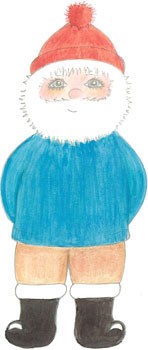
Salty Sam’s Fun Blog for Children
Number 373
Bats
Hello Everyone

l have a question for you.
Which is the only mammal that can fly?
Well of course, l know that you already know the answer to that question because you saw the title of this blog post at the top of the page.
And you saw the picture as well.
What a cute little face.
Did you know bats could be this cute?
Lots of people hate bats; even grown-ups.
They start freaking out when bats start flying near them. They may have heard that bats are the only mammal that feeds on blood!
But of course most of them don’t.
Other people are fascinated by bats and go out at night to especially look for them.
Birds dominate the skies in the day time and often catch flying insects while they are on the wing.
To avoid being eaten by birds, a lot of insects come out at night instead.
That is when the bats come out to feast.
lf you see what seems to be a bird flying around at dusk or in the dark and it is darting about all over the place, it might not be a bird at all, but a bat.
A bat’s wing is actually a hand that has adapted through evolution for flight. Consequently their wings are very manoeuvrable and enable the bat to move themselves quickly in any direction whilst in the air.
Bats live in all sorts of hidden places and hide away during the day time so that you won’t normally see them. You may be surprised then to hear that it is very possible that there are bats living near you.
There might be some bats living quite near you, and you won’t see them unless you go looking for them. Some people take bat detecting kits outside at night so that they can hear the sounds the bats are making, and also to identify which bats are flying overhead, because each species will make their own specific sounds.
We hear bird song really easily, but the sounds that bats make are very high-pitch and outside our hearing range. We cannot hear them with our ears normally.
Humans cannot hear the sounds that the bat makes without a machine called a bat detector. The bat detector can even tell you which kind of bats are flying above you by the noise they are making, even sometimes when you can’t even see them in the darkness.
The bats find different places to live during the year. They don’t make nests like some birds do. They live in what we call roosts. Roosts are just places where they can hang from a ceiling.
For hibernation over the winter, they need a cool but frost-free place. Their bodies become very still. They slow their breathing and lower their body temperature. This is called being in a state of torpor.
But for a maternity roost, where only females and their young live, bats need a warmer place. Females have a single baby, called a pup, each year in the early summer and look after them while they are very young. The males find their own roosts at this time.
Bats like living in quiet caves or cave-like places like hollow trees because they need to find a roof to hang from.
Since humans started making buildings, bats have found these useful places to set up home too.
Bats are sometimes found in churches because these are large spaces with high ceilings – and also without people constantly moving about in them.
They also like living in other man-made places like barns, mines, tunnels and bridges where they are left undisturbed. They can be quite active during the day time in the summer but it is at night they go on the wing.
A famous urban roost is situated under a bridge is in Austin, Texas.
Every night in summer, hundreds of people gather to watch about one and a half million Mexican free-tailed bats fly out from under the Congress Avenue Bridge and swoop overhead. lt is a wonderful spectacle.
The bats migrate from Central Mexico to this roost where the females give birth.
When the people making the bridge designed it, they had no idea that it would be so attractive to bats to make a home; and these bats come back to it very year.
Worcester Cathedral has the only known inner city population of bats in Britain. They are lesser horseshoe bats. A river runs nearby and there are fields and woods beyond for them to find food.
Sometimes the Worcester street lights are turned off for the bats so that they can have dark runs to fly through.
These runs are called commuting habitats.
When darkness falls, the bats set out on their hunt for food. They use echolocation to find their prey. This means that they send out signals which bounce off creatures and when the signal bounces back to the bat, they know where the creatures they want to eat can be found. This is usually flying insects or invertebrates in trees.
Bats also use vision and their sense of smell to find food. They have large and sensitive ears. They can sometimes even hear a tiny insect walking on a leaf!
Some people think that a bat could hit them or get caught in their hair. This is very unlikely with the bat’s wonderful ability to find their way around and detect objects.
They send out echolocation to locate the small invertebrates they are trying to find. lf they can find a little insect, they will certainly be able to detect a human and not fly into them!
Bats can eat up to 3,000 insects in a night.
They swoop over rivers where insects congregate. They fly through forests where food is easy to find too, and where there are also places to rest for a while where they can eat some large prey that they have caught.
These kinds of places are called foraging habitats.
lnsects can often be seen swarming over the surface of rivers at certain times of the year, and these attract bats looking for food.
Bats can also be seen over farmland or gardens.
Bats are really very useful to people all over the world. They help them by killing insects that destroy crops and spread tropical diseases.
There are more than 1,000 species of bat in the world and the number is probably much higher than that.
What may really surprise you, is that bats make up about one-fifth of the mammal population on Earth.
ln Britain they are a protected species. The roosts are protected by law as well as the animals themselves.
lf bats come to live in your property, you cannot evict them or even disturb them. You can’t trap or handle a bat without a licence.
You can’t kill or injure a bat and you can’t destroy a roost even if there are no bats living there at the time.
lf you ever get bitten by a bat, because maybe you are trying to pick up an injured one – even though you shouldn’t touch it, you must go to hospital straight away.
Even some British bats carry rabies and your life can be saved if you get to a hospital quickly enough.
You can call the National Bat Helpline for help and guidance if you need it.
We have 18 species of bat in Britain, which is a quarter of our number of mammal species, but their numbers have declined over the past decades which is why laws were passed to protect them.
Some of them are really tiny; some of them are very rare. All British bats eat insects. Bats in other places eat fruit, nectar, pollen, frogs, fish and other bats.
Some other species of bat sometimes visit us from the Continent.
The biggest bats in the world are the flying foxes with a wing span of up to 2 metres. The smallest is the bumble bee bat, and at only 2 grams it is the smallest mammal.
lf you want to encourage bats into your garden, there are a number of things you can do.
You can put up bat boxes, build a pond, plant hedges and lots of flowers and reduce artificial lighting in the area if you can. Don’t use poisons.
You could even join a local bat group.
And before you ask, no, Batman will not be in charge!
![]()
lf you like my blog, please support it by telling all your friends and followers about it.
Thank you!
And see you again next Fun Friday!
Love and kisses
Salty Sam

www.christina-sinclair.com


Bill and Bob’s Joke of the Week![]()
![]()
Bill: lf Batman is so smart?
Bob: Yes?
Bill: How come he wears his underpants on the outside of his trousers?
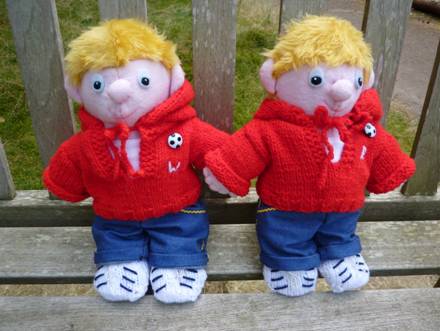
Salty Sam © Christina Sinclair 2015
Unauthorized use and/or duplication of material from this blog without express and written permission from this blog’s author and owner is strictly prohibited.
Links may be used to www.christina-sinclair.com

Picture Gallery

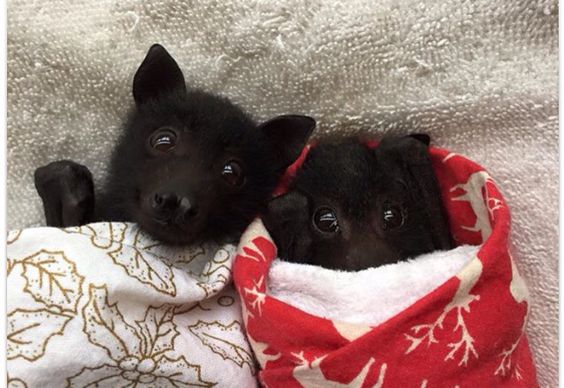
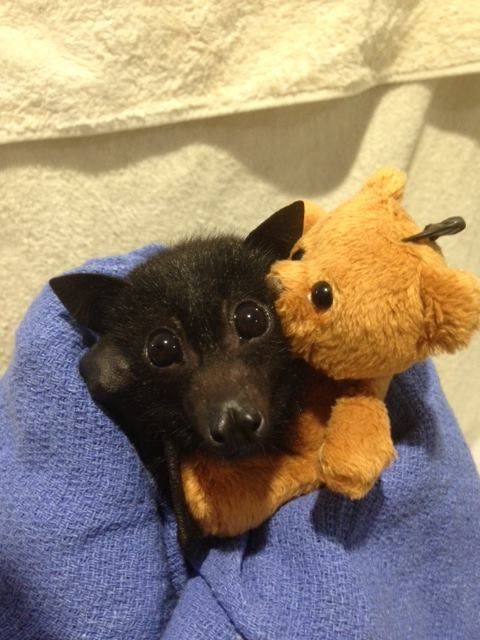
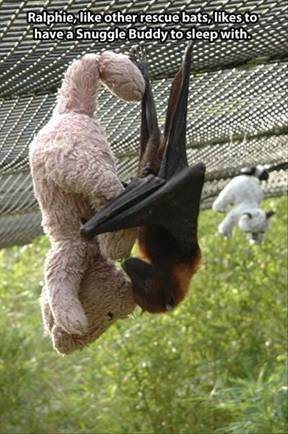
Worcester Cathedral



 THE SALTY SAM NEWS DESK
THE SALTY SAM NEWS DESK

This is a very busy time of year for Auntie Alice in her garden.
There is much sowing of seeds to be done outside in the flowerbeds and vegetable patch and inside the greenhouse as well.
There are so many colourful flowers in Auntie Alice’s garden in the spring and summer and autumn that bees and butterflies love.
These kinds of flowers don’t just grow in large gardens; they grow in hanging baskets and in pots on balconies as well. Flowers like daisies and nasturtiums are a good choice for small gardens.
And of course, it is more important than ever that Auntie Alice has forage for bees because she has her own to feed now.
And this year she wants to start a third and even fourth hive up!
Her bees have a good temperament and so she is hoping to catch an old queen when she flies off with a swarm and put her and her attendants in a new hive. The additional hives will then have bees with the same good temperament.
In the spring, the bees take food from flowers in the trees as well as those in the flower beds. The earliest tree flowers are green and tiny, then as the spring progresses the pink and white fruit blossom will appear.
Trees that provide food for bees are sometimes referred to as ‘acres in the sky’.
But Auntie Alice has also decided to put a little patch of her enormous garden aside for butterflies to live in.
It will be a tiny square surrounded by various types of hedges. She will let the grass grow and has told the children not to walk through it and disturb anything.
The patch of ground is right in the corner of the garden and out of the way.
It will look a bit scruffy when the grass remains un-mown, but it will be a long way from the house and quite unseen from the windows. The grass will be at waist-height by June.
She already had a patch of nettles there; these are very important caterpillar food.
There will be primroses and forget-me-nots for spring nectar.
Candy tuft and scabious will be grown for summer nectar, and of course the butterfly favourite verbena bonariensis will be very popular.
There will also be wild thyme and marjoram.
In the autumn, Michaelmas daisies and rudbeckia will provide the butterflies with forage as well as the ice plants which are growing out of the top of an ancient, tumbled-down wall in the corner.
Tucked up against this wall will be some buddleja bushes. These will grow to be very tall.
These bushes are sometimes called the butterfly bush because they are so loved by many different types of butterfly.
There is already some mature ivy growing in the part of the garden but Auntie Alice has planted some holly bushes as well.
In order to make sure that butterflies and bees are happy in your garden, it is very important not to use chemicals.
Auntie Alice has told the children to watch to see if they think they see more butterflies around in the garden this year as a result of her efforts.
She has put a butterfly spotter’s chart up in the kitchen and they will keep a record of all the species they see.
It will be a very exciting project for everyone.


NEWSDESK MINIMAKE
A CUTE LITTLE SPARKLY BAT
You don’t have to make this bat out of sparkly yarn; he will still look cute in plain black yarn.
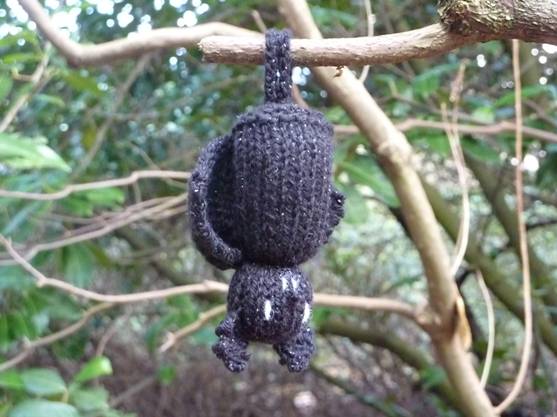
You can give him red eyes instead of silver-grey if you want to make him look scarier; and you can give him a grey nose if you want to make it more noticeable.
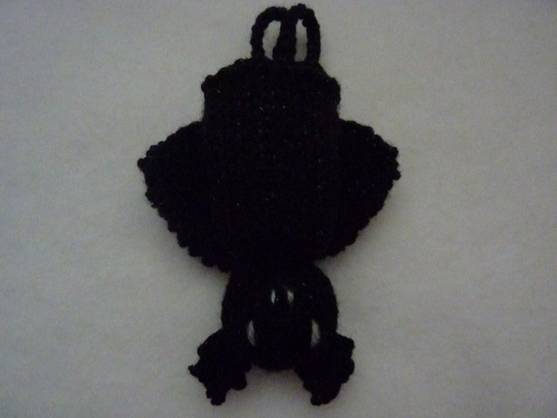
BAT BODY AND HEAD (KNIT ONE)
Using 4mm knitting needles and black sparkly dk yarn cast on 20 stitches
Knit 2 rows of garter stitch
Knit 26 rows of stocking stitch
Don’t cast off – cut your yarn off with about 20cm to spare and leave your stitches on this length of yarn
BAT EARS (KNIT TWO)
Using 4mm knitting needles and black sparkly dk yarn cast on 5 stitches
(Knit these ears in garter stitch)
Knit 1 row
Decrease 1 stitch at the beginning of the next 4 rows of garter stitch (1st)
Cast off
BAT WINGS (KNIT ONE)
Using 4mm knitting needles and black sparkly dk yarn cast on 20 stitches
Knit 20 rows of garter stitch
Don’t cast off – cut your yarn off with about 20cm to spare and leave your stitches on this length
BAT BASE (KNIT ONE)
Using 4mm knitting needles and black sparkly dk yarn cast on 40 stitches
Cast off
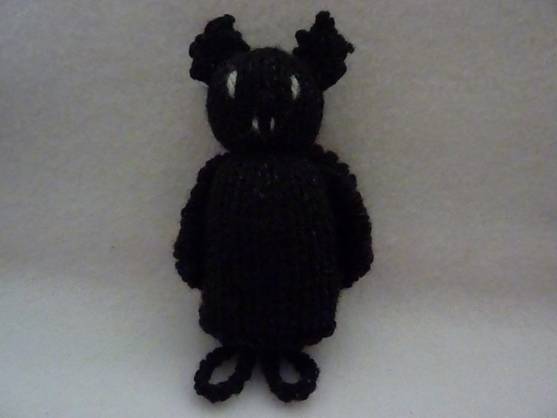
TO MAKE UP
- Sew the back seam of the head and body using over-sew stitches and then turn the body the right way out
- Pull the top of the head in
- Stuff the body and make the bat nice and plump
- Tie a length of yarn tightly around the neck twice and secure ends into the back of the neck – neaten ends
- Sew the base into a spiral
- Insert the base into place and sew around edges
- Bring the yarn at the top of the ear down the inner edge and sew the ears to the top of the head
- Use a French knot to make the nose (wind the yarn 5 times around your needle)
- Sew on the eyes with grey yarn and fangs with white yarn
- Pull the top of the wings in and sew the centre of the wings panel to the back of the bat down his spine – the wings can rest by his side or spread for flight
- The bat can sit up or hang upside down
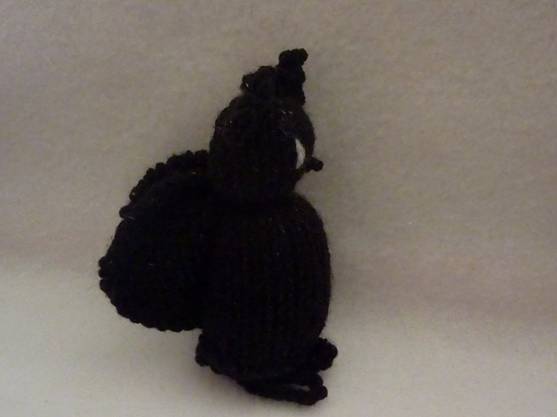
BAT FEET (MAKE TWO)
Crochet 15 chains into a length of the black sparkly yarn
Tie the ends together to create a loop of chains and sew each foot into the base of the bat so that the chain loops can be used to hang the bat up


*********************
TO ADVERTISE ON THIS BLOG
PLEASE CONTACT:
christina.sinclair.ads@aol.co.uk
*********************


Quick Quiz
Can you answer these questions?
- Which bats famously drink blood?
- Who wrote Dracula?
- What is the pointed roof of a church called?
- What does ‘bats in the belfry’ or ‘batty’ mean?
- Why don’t most fruit bats use echolocation?




lt’s the Weekend!

HOW TO MAKE A SMALL POUCH-PURSE
This purse is big enough to hold quite a few bank notes.
It has a square base that can be made more rigid with a piece of card cut to size. The card needs to be a 7cm or 2¾ inch square.

PURSE BASE (KNIT ONE)
Using 4mm knitting needles and green dk yarn cast on 17 stitches
Knit 20 rows of stocking stitch
Cast off
PURSE SIDES (KNIT FOUR)
Using 4mm knitting needles and green dk yarn cast on 17 stitches
Knit 28 rows of stocking stitch
Knit 1 row
Knit 1 row
Knit 1 row
Purl 1 row
Purl 1 row
Purl 1 row
Knit 1 row
Knit 1 row
Knit 1 row
Knit 1 row
Cast off
TO MAKE UP
Using over-sew stitching sew the bottom of each side to the base of the purse wrong sides together to make sure you get a neat box shape with sharp corners.
Then sew up the sides of the purse in the same fashion.
Make a cord to thread through the channel at the top of the purse by crocheting 70 chain stitches into a length of yarn either in the same colour as the purse or a contrasting colour.

Please note that the material on this blog is for personal use and for use in classrooms only.
It is a copyright infringement and, therefore, illegal under international law to sell items made with these patterns.
Use of the toys and projects is at your own risk.
©Christina Sinclair Designs 2015


Quick Quiz Answers
- Which bats famously drink blood? Vampire bats are native to the Americas
- Who wrote Dracula? This was a novel written by Bram Stoker in 1897
- What is the pointed roof of a church called? A steeple
- What does ‘bats in the belfry’ or ‘batty’ mean? Crazy – ‘he’s got bats in the belfry’ or ‘she is a bit batty’
- Why don’t most fruit bats use echolocation? They are herbivores (eat plants) not insectivores (eat insects) so they rely on their senses of sight and smell to find food

Count Dracula


